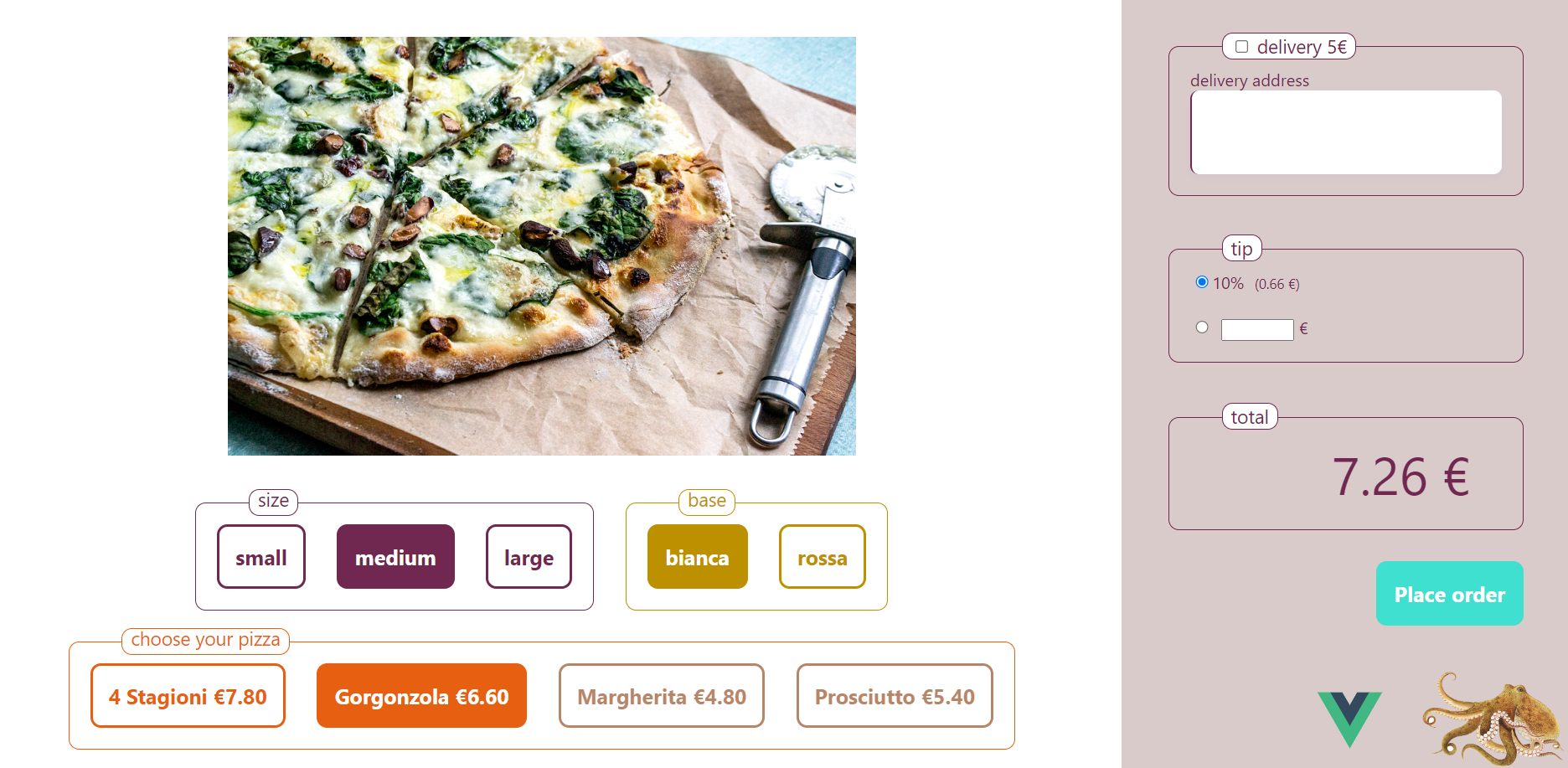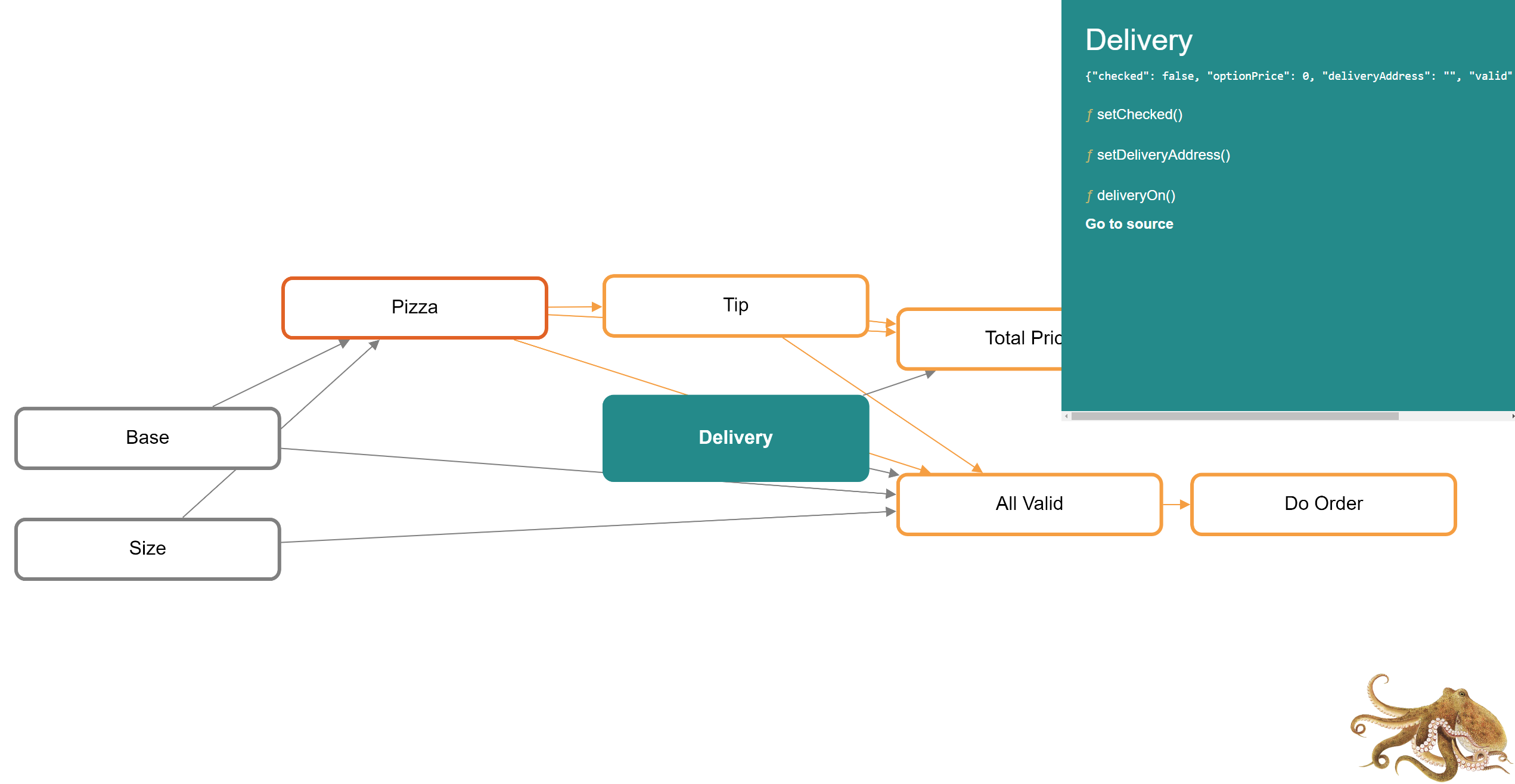The state and behaviour of our applications have a logical structure distinct from the structure of the DOM, and this structure, it turns out, is a directed acyclic graph. The DOM is a tree. A DAG differs from a tree in that a DAG node can have many parents. Worse, the DOM (and the tree of framework components behind it) represent the visual structure of your rendered page, which has little to do with the logical structure of your app.
When we try and shoehorn state-and-behaviour into the DOM tree, shared state ends up arbitrarily in a common ancestor, and behaviour ends up all over the place. Props are used excessively to pass state and behaviour wherever it's needed, and the logical structure is obscured.
State management solutions will help you get shared state out of the DOM, but, in prioritising state over behaviour while imposing their own dose of complexity and concepts, they do little to bring the inherent logical structure of your app to light.
Octopus invites you to put your shared state and the logic that acts on it in nodes. Nodes can read other nodes, but not change them. Octopus organises your nodes into a DAG, based on what they read. It checks for cycles. Then when a node changes, octopus coordinates a traversal of dependent nodes, ensuring that all your state is always consistent, while eliminating needless recalculation.
As such...
- The emergent logical structure is clearly separated from the visual one, and can be visualized. Octopus comes with a devtools that lets you inspect the structure and live state of your running application.
- nodes are loosely coupled. You can modify and extend your app by adding nodes, without changing a line of existing code.
- cross-cutting concerns can be implemented as wrappers. Again, you can add wrappers without changing a line of existing code.
- developer comfort: node code is biblically simple. There's no learning curve. Nodes look like objects, with values and the methods that act on them. If they depend on upstream nodes, this dependency is encapsulated in a reup function. That's it. This very simple structure can accomodate everything.
- async is no problem.
- framework UI components become much simpler. Components can directly observe state in nodes, and you can get rid of 90% of your props (and useState(), useContext() and your existing over-engineered state management solution).
- needless calculation is eliminated. State is always consistent.
- tiny and performant. The bundle is 13k.
DAGs are much discussed in comp-sci (and implemented internally all over the place), but Octopus appears to be the first reusable, turnkey, ready-to-wear, off-the-shelf implementation of a DAG for application development, in any language, that I'm aware of. 1
This turborepo contains:
- octopus-state-graph, the source of the npm package, ready for use in your apps.
- two sample applications in React and Vue
- octopus devtools, as a locally hosted popup, which can also be packaged and installed as a Chrome extension. Visualize the emergent structure and live state of your running application.
git clone https://github.com/bbsimonbb/octopus-turbo.git
cd octopus-turbo
npm install -g pnpm
pnpm install
pnpm run dev
In the apps folder, there are two versions of the same sample UI, shown above, one with React, one with Vue. Click around. Simple on the surface, there are a lot of rules to implement...
- Total price sums pizza, delivery and tip. The value of tip may depend on the value of pizza
- Any of the five user controls can invalidate the order.
- The state of the (orange) pizza control depends on user input, the size chosen and the base chosen.
- Warnings only show if you've interacted with a control, or if you've tried to submit.
- Warnings only show if preconditions are met. Why bully you to choose a pizza when you haven't chosen a base yet?
Like many (all?) UI's, this UI is a directed acyclic graph. It could be modelled as an object-oriented system, or an event-driven one, or with a functional paradigm, but it intrinsically is a directed acyclic graph, because this is the loosest possible structure that doesn't admit infinite loops. The order of controls on screen is usually a good approximation of the structure of the graph, but of course in a UI the user can interact with controls in any order. How are we going to ensure that the state is always consistent? Let's see what happens when we make the graph structure explicit...
This graph, generated by octopus-state-graph, visualized with octopus devtools, shows you the structure and state of your running application. Essentially, each user control on screen is underpinned by a node in the graph. A node encapsulates a meaningful concept in our subject domain.
As we started to see above, Octopus has essentially two functions: Firstly, on build(), it builds the graph based on the call signatures of all the recalculate functions, checking that the requested dependencies exist, and that no cycles are created. A node's recalculate function is called reup() because it's shorter and I'm a huge wire fan.
Secondly, octopus ensures that when a node changes (when a function returns), the graph will be traversed, and all the reup() functions starting with that of the changed node, will be called sequentially. (The sequence is determined by the topological sort of the graph.) As such, for any given external change, a node only recalculates if it is downstream of the change, and it only reacalculates once, after all it's predecessors have updated.
(There is a ton of scope for optimising traversals. Functions could report if they made a change, or we could detect this. Nodes would then be reupped only if necessary. Going further, a tricky implementation with promises could let different branches of a traversal proceed independently, such that a slow node only delayed downstream branches that depend on it. Stay tuned!)
Nodes can fetch data. In many situations, it will make much more sense to fetch your data into this persistent, reactive structure, rather than fetching from your UI components that come and go as the user navigates. Unlike a reducer, a graph traversal will happily wait while a network call completes, and downstream nodes will then recalculate taking account of the fresh context.
Alternatively, a node can launch a network request and return immediately. Antecedent nodes might go into a waiting state, which you can use to control spinners etc. Then when the fetch returns, a node method handles the return and a new traversal is initiated, clearing the spinners and displaying the fresh data and any cascading effects. In either scenario, and unlike react query, the logic that decides when to refetch lives on the node, together with the api call and the resulting data.
So now the picture emerges. DAGs hit a sweet spot in the middle of the three common programming paradigms (OO, event-driven, functional). Your nodes lie at the intersection of your system and the outside world. Like in OO, they encapsulate a bit of state, and the methods that modify it. Like event-driven systems, they can "subscribe" to relevant changes and their responsibility ends when they publish their value. There's a hat-tip to functional programming and one-way data flow in the notion of a traversal, but this approach is intentionally much less dogmatic. State, both private and published, can accumulate in nodes, and reup() functions can be async and impure. And we get to mutualise, in the reup() function, the magic sauce that combines some user input with the current state of the system to produce the node's current value, a value to which downstream nodes can then react. All this is done with no funny business. Node values are not proxied (node functions are), there's no expensive change detection and very limited passing around of functions. There are no new concepts. Node code is biblically simple.
Graph-oriented applications, let's call them, have an emergent structure. When we've added all our nodes, we call build() on the graph. Octopus constructs our graph, checking that there are no cycles, and producing a sequence for traversing, a topological sort. This structure can then be visualised in Octopus devtools. The visualisation reads from left to right, with sources on the left, and sinks on the right. Hovering over a node highlights its predecessors and antecedents. When we interact with our app, the node which has received our user input is highlighted. Clicking a node in the devtools opens the details pane, displaying the node's current published value and methods, and we can go directly from here to the node source. This makes it very easy to reason about, as they say, the structure and behaviour of our application.
A super possibility of octopus is reporting nodes. A reporting node chooses its predecessors not by name, but with a filter function. Look at the totalPrice and allValid nodes in the sample applications to see how this is done. Any new node whose published val contains a price will automatically contribute to the total.
A further possibility is node wrapping. A node wrapper is just a function called after reup(), giving you a second chance to modify, or add to, val. In this way, you can handle cross-cutting concerns without having to intervene in the code of the wrapped nodes. Call wrapNode() anytime before build, even before the node itself is added. You will be warned at build time if you've tried to wrap a node that doesn't exist. Nodes can have many wrappers, sorted by priority. Wrappers can choose their nodes by name, or, like reporting nodes, with a filter function, reupFilterFunc.
The last thing to cover is serialisation. In complex applications, you may want to be able to save and reload your graphs. To do this, we should distinguish between hot and cold state. Hot state is the full picture, presented to the UI layer. In this pizza example, the full list of option values (present in the hot state) comes from the source code, so there's no need to duplicate it into the cold state. The cold state will just need to include the user's choices among the options. The total price is trivially calculated so again there's no need to save it. So to save our graph, we just need to implement saveState() and loadState() on our options. When we call graph.saveState(), we get a little object containing just the saved user input, together with two properties that allow us to efficiently rehydrate the graph without needing to rebuild.
See the tests for working simple examples. Essentially you need to...
const graph = createGraph()
graph.addNode("nodeName", aNode)
...
if(/* you're starting afresh */)
graph.build()
else
graph.loadState( JSON.parse(savedState) )
// your UI is live, then when you're finished...
const savedState = JSON.stringify(graph.saveState())
To integrate with a front-end framework, we just need the framework to observe the node. In Vue, this is easily accomplished by wrapping the node in reactive(). For react we need to grab mobx, and wrap the node with makeAutoObservable(), and our react components with observer(). Additionally, mobx likes you to tag state-modifying functions as actions, so that all actions can complete before the DOM is modified. If you pass mobx.action() to octopus when you create your graph, octopus will look after this for you. You should also wrap any callbacks you create inside reup() and node functions. All this is demonstrated in the React sample.
DO NOT MISS the devtools extension (screenshot above). You can visualise the graph of your UI, see in real time what nodes you're interacting with, what value they publish, and navigate directly to the source. Click the octopus to bring up devtools in a popup. It's not in the Chrome store yet, so to install it you'll need to download and build the project, then Extensions => Pack extension
Footnotes
-
In the React space, Jotai is perhaps closest in spirit (atoms can take dependencies on other atoms). Following this discussion on hackernews, I'm now aware of Dagger and Guice, DI frameworks for java, and XState state management and orchestration for js/ts. I'm developing this to scratch my own itch, and the conviction that I'm onto something is only strengthening, so development continues! ↩


